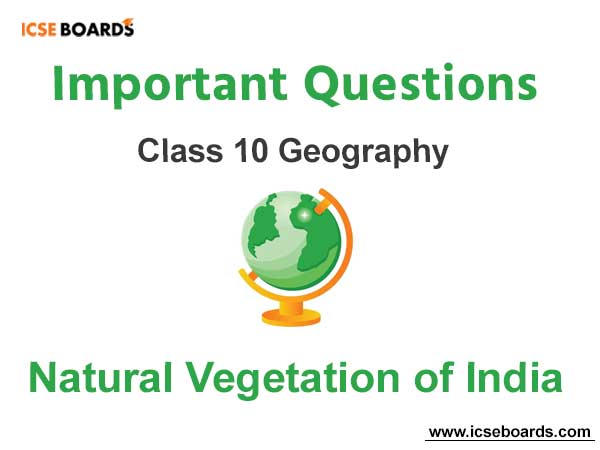Students of ICSE Class 10 should refer to Natural Vegetation of India ICSE Class 10 Geography Questions below which have come in past board exams. You should always go through questions that have come in previous years. This will help you to understand the pattern of questions in ICSE Class 10 Geography and prepare accordingly. This will help you to get better marks in ICSE Class 10 Board Exams
ICSE Class 10 Geography Natural Vegetation of India Important Questions
Students should learn the important questions and answers given below for Chapter Natural Vegetation of India in Geography for ICSE Class 10. These board questions are expected to come in the upcoming exams. Students of ICSE Class 10th should go through the Important questions and answers ICSE Class 10 Geography which will help them to get more marks in exams.
Board Exam Questions Natural Vegetation of India ICSE Class 10 Geography
Natural Vegetation of India ICSE Class 10 Geography Important Questions
Question. What do you mean by natural vegetation?
Ans. Vegetation that grows without the interference of man and adapts itself to the limitations of the natural environment
Question. Today natural vegetation is found only in remote areas’. Why?
Ans. Natural vegetation has been cleared from accessible areas due to the growth of population; to make space for settlement, agricultural land, industries and infrastructural development
Question. What are the geographical factors affecting the natural vegetation of a place?
Ans. Geographical factors affecting the natural vegetation of a place are climate, soil and topography.
Question. Give three characteristics feature of the trees that are found in the evergreen forests?
Ans. The three characteristics of trees in the evergreen forests are
1. Dense growth of vegetation
2. Broad leaves
3. Dense canopy
4. Trees not found in pure strands (massive variety)
5. Provides valuable hardwood
Question. Name two varieties of trees that are found in evergreen forests.
Ans. Rosewood and Shisham
Question. Mention any two places where this forest is found in India.
Ans. Evergreen forests are found in western slopes of Western Ghats, West Bengal and Andaman & Nicobar Islands
Question. Why is the floor of evergreen forest dark?
Ans. The floor of evergreen forest is dark as sunlight cannot penetrate through the broad, dense and interlocking canopy
Question. Mention three characteristic features of tropical deciduous forest.
Ans. 1. Trees shed their leaves in spring season.
2. Wood is found in pure strands.
3. Trees are economically very important.
Question. Name five trees of the Monsoon forest.
Ans. Teak, Sal, Semul, Sandalwood, Myrobalan
Question. Name any three states where this forest is found.
Ans. MP, Chattisgarh, Assam, Orissa, Karnataka
Question. Why are the deciduous forests economically more important than the evergreen forests?
Ans. 1. Trees are not densely spaced so they are easy to cut.
2. Wood is of good quality
3. Wood is cheap and readily available
4. There are many uses of the forest products
Question. Mention one use of the following: Sal, Teak, Sandalwood, Semul, Myrobalan
Ans. Sal: Used to make railway sleepers
Teak: Used for making furniture & ship
Sandalwood: Oil used for perfumery
Semul: Match boxes & packing cases
Myrobalan: Dyeing of cotton, silk and wool
Question. Mention any three adaptations made by the trees of desert along with justification.
Ans. 1. Long roots to tap ground water from greater depth
2. Small leaves and spines to reduce water loss through transpiration
3. Spines to protect themselves from predators
Question. Name two trees found in the tropical deserts of India.
Ans. Babul & Date Palm
Question. Which states of India has this type of vegetation?
Ans. Gujarat & Rajasthan.
Question. What is the function of the stilted roots in the Tidal forest?
Ans. Stilted roots help in respiration of the trees since soil is waterlogged all the time.
Question. Name one place in India which is famous for this type of forest.
Ans. Ganga Brahmaputra delta
Question. Name any two trees that are found here.
Ans. Sundari , screw pine, agar, keora
Question. Why does the vegetation change with elevation?
Ans. This is because climate, soil and topography change with elevation.
Question. Name any three trees that belong to Mountain forest.
Ans. Pine,deodar and fir.
Question. Mention the uses of these trees.
Ans. Pine: Making of turpentine and tea chest
Fir: Making of matchbox, paper and pulp.
Deodar: Making of railway sleepers.
Question. What is forest conservation?
Ans. Proper and sustainable use of forest resources without causing any adverse effect on our economy or
environment
Question. Name any two forest conservation programmes.
Ans. Vanamahotsava and Chipko Movement.
Question. Mention the objectives of forest conservation
Ans. 1. Check indiscriminate deforestation
2. Prevent overgrazing
3. Control shifting cultivation
4. Carry out deforestation and reforestation in quick succession
5. Efficient utilization of forest products
Question. Name the four major natural vegetation belts of India
Ans. 1. Tropical Evergreen forests: Windward Part of Western Ghats
2. Tropical Dry forests: Rajasthan, Gujarat and Punjab
3. Delta or Tidal forests: Sunderbans
4. Mountain Vegetation: Himachal Pradesh, Kashmir
5. Tropical Deciduous or Monsoon Forests: Rest of India
Question. What is the rainfall range of (i) Tropical evergreen rain forests and (ii) Thorn and scrub forests?
Ans. Tropical evergreen rain forests: 200cm Thorn and scrub forests: less than 25cm.
Question. Name the type of forests found in the Sundarbans of West Bengal and Bangladesh.
Ans. Tidal Mangrove Forest.
Question. What is the difference between afforestation and reforestation?
Ans. Aforestation – Planting trees in any place. Reforestation – Planting trees in deforested areas.
Question. Explain, why Deciduous Monsoon Forest are found on the eastern part of South India?
Ans. Being on the leeward side of the Western Ghats, the region receives rainfall of 100-200 cm which supports the growth of deciduous forest.
Question. Where are dry thorn forests found in India? Name two important trees that grow in these forests.
Ans. Dry thorn forests are found in Gujarat and Rajasthan. The two important trees are Babul, neem and Ber.







